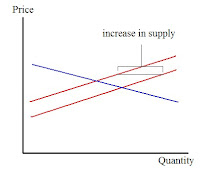I cannot properly do this without using Bayes' theorem, so I need to explain that first. (Bayes' theorem is very useful, and I would recommend learning it even if you don't care about 9/11 conspiracies.)
In plain English, the theorem says you should take prior probabilities into account when judging how likely something is. Symbolically, it can be formulated like this:
I'm using "H" to stand for "hypothesis", and "D" for "data". P(H) is the probability that the hypothesis is true, to the best of our knowledge, before we examine the data. "~" means "not", so P(~H) is the probability that it is not true, as far as we can make out, before we look at the data.
This means the first third of the equation,
P(H|D) is the probability that the hypothesis is true, after taking into account the new data. P(~H|D) is, likewise, the probability that it is not true after accounting for the new data. Thus, the right side of the equation,
Lastly, in the middle, we have
We can now make the equation more manageable by substituting English:
Let me use an example. Let's suppose you went to a doctor, suspecting you had a certain disease. We'll say the hypothesis, H, is that you have the disease. According to studies, only 1 in 10,001 people have this disease. So the prior odds that you have it are 1/10,000.
The doctor then takes a blood sample and runs a test. The test is 99% accurate, making the likelihood ratio 99. It comes back positive.
This is really terrible news. Or is it?
If we do the math to find out the odds that you have the disease, taking all the data into account — solving for the posterior odds — we get 99 to 10,000, or slightly less than a 1 in 100 chance that you have the disease.
How did that happen? Basically, because the disease is so rare, you're 100 times more likely to be a healthy person who receives a false positive than to be someone who actually has the disease.
On to the point. When I think about 9/11 conspiracies, I think about them in Bayesian terms. This time let H be the hypothesis that George Bush orchestrated 9/11. What's the likelihood — ignoring the evidence collected after the fall of the twin towers — that president Bush could have coordinated all of this? Given the complexity of the operation, it would have been very difficult. Not to mention that there must have been dozens, if not hundreds, of top officials involved in this, all of whom had a good chance of being treated like heroes if they prevented it. How did he keep them from talking? How did he keep other people from noticing? The whole idea strains credulity. How about the angry Muslims hypothesis? After 50 years of malevolent U.S. intervention in the Middle East, it sounds pretty plausible. Even more so after the U.S.S. Cole incident. Because of the extreme imbalance between the two options, I'm giving the prior odds the value of 1/500.
What about the evidence collected after the disaster? I guess it's plausible it could have been caused by explosives. It's also plausible (to me) that 9/11 conspiracy theorists are not very good at forensics, and simply read too much into the evidence. So I'll give the likelihood ratio a value of 1/1, or just 1. Wow, that's a little unsettling, a 50/50 chance that the evidence was caused by explosives! Well, no, not really. If you do the math,
Now, I get the impression that many 9/11 Truthers, like the patient who panicked earlier after getting positive results on his blood test, are looking at their data out of context, ignoring the extreme unlikelihood of their hypothesis in the first place.
Just for fun, let's take this a little further. Even if I give assumptions that are far too kind, it's still unlikely:
And that's why I don't bother with this issue.
